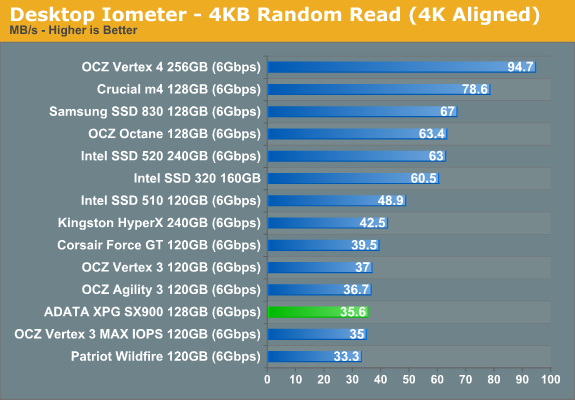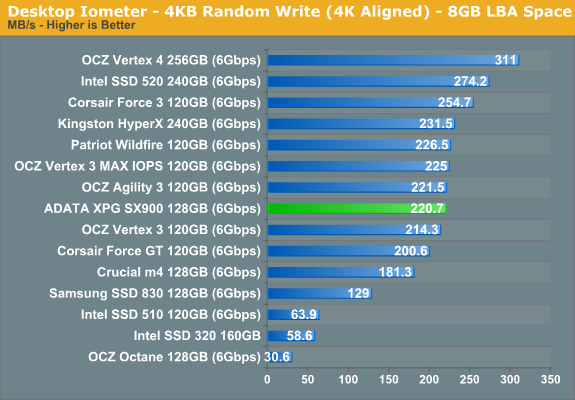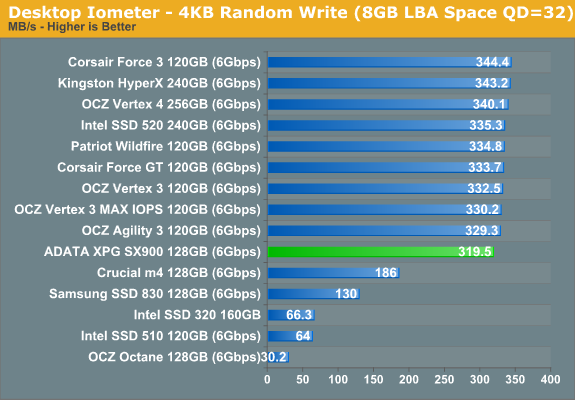ADATA XPG SX900 (128GB) Review: Maximizing SandForce Capacity
by Kristian Vättö on June 8, 2012 1:25 AM ESTRandom Read/Write Speed
The four corners of SSD performance are as follows: random read, random write, sequential read and sequential write speed. Random accesses are generally small in size, while sequential accesses tend to be larger and thus we have the four Iometer tests we use in all of our reviews. Our first test writes 4KB in a completely random pattern over an 8GB space of the drive to simulate the sort of random access that you'd see on an OS drive (even this is more stressful than a normal desktop user would see). I perform three concurrent IOs and run the test for 3 minutes. The results reported are in average MB/s over the entire time. We use both standard pseudo randomly generated data for each write as well as fully random data to show you both the maximum and minimum performance offered by SandForce based drives in these tests. The average performance of SF drives will likely be somewhere in between the two values for each drive you see in the graphs. For an understanding of why this matters, read our original SandForce article.

Random read performance has never been a strength of SandForce as even Intel SSD 320 outperforms most SandForce based SSDs. As the graph shows, the SX900 is on-par with other 120/128GB SandForce drives.

4KB random write performance is no different from other SandForce drives. Only Intel SSD 520 and Corsair Force 3 are noticeably faster, while others fall in the same 215-230MB/s range.

Increasing the queue depth to 32 doesn't change the story. While the SX900 is the slowest SandForce drive in this test, it's less than 5% slower than the majority of SF-2281 drives.
Sequential Read/Write Speed
To measure sequential performance I ran a 1 minute long 128KB sequential test over the entire span of the drive at a queue depth of 1. The results reported are in average MB/s over the entire test length.


Both sequential read and write speeds are almost the same for all SandForce SF-2200 series SSDs and the SX900 is no exception. This isn't a surprise given that the firmware is essentially the same in all SandForce SSDs, with the exception of the Intel 520 series.










58 Comments
View All Comments
Kristian Vättö - Monday, June 11, 2012 - link
TheJian,Reading your comments actually got me interested in the whole situation. It's kind of odd to see increasing profits given that the companies were "struggling" due to floods just a few months ago. A quick conclusion would be that the HD market was getting too low-profit now that SSDs are becoming more and more popular, so the HD companies decided to blame the floods and use that as a tool to limit supply temporarily and increase prices.
I'll talk to Anand and see what he thinks. This is definitely an intriguing topic - maybe the HD companies are just ripping people off?
TheJian - Wednesday, June 13, 2012 - link
In my opinion, based on the numbers, that isn't really a question. It's a REALITY. There is NO other way to look at it. Hopefully Anand will come to the same conclusion and post an article about it. I see Dailytech picked up the article I referenced and posed it (shame...LOL - At least it wasn't Mick...). I was going to just paste my stuff onto that post from the 11th, but I didn't want to give them more hits for whoring out my post...ROFL). I don't want to see that crap repeated, I wanted it TORN APART! :)Instead of excusing them, the post should have discussed why they are getting rich during a supposed catastrophe. That is what needs to be analyzed. Why do they continue to rip retail users off? None of us signed some contract thinking no drives would be available. So why am I forced to pay a higher fee? Just to make Dell/HP feel better about getting ripped off?
PRODUCTION is in full swing at both WD and Seagate. This quarter is the first they will exceed pre-flood drive sales. Then why am I still be screwed at the store? Why did Externals NEVER go up? The same thing should be true at retail/newegg/amazon etc...Those prices have no reason to be high now with production about to EXCEED pre-flood production. What catastrophe are we in now? Is there another LARGER flood I'm unaware of that continues to hurt drive pricing? It seems completely made up at this point, when looking at the profits they are raking in (RECORD PROFITS!). Just tell Anand to look at their profits for Sept 2011 (pre flood), Dec2011 (the actual damage quarter) and 1st quarter 2012 (the complete RIPOFF quarter). I'd like to see another follow up next month or so when we get the June quarter's numbers as they will show HUGE profits for both no doubt.
Thanks for looking into it! :)
jwilliams4200 - Wednesday, June 13, 2012 - link
Actually, there is another way to look at it -- basic economics, supply and demand.The flood caused a "supply shock" (look it up on wikipedia), reducing the overall number of HDDs that could be supplied to consumers. As a result, the market price adjusted sharply higher in order to reduce demand to the amount that could be supplied. That is basic ECON 101 behavior, and not at all mysterious.
WD's production was cut sharply by the flood, but Seagate's production was not as badly impacted, as some of your figures show. But since WD HDDs and Seagate HDDs are "substitute goods" (wikipedia it), the supply curves are closely linked. So Seagate did indeed profit from the overall reduced supply, since WD lost more production. Again, this is all basic economics, and nothing nefarious is needed to explain it.
Now that production has nearly returned to pre-flood levels, there is still reason for prices to be higher than before -- pent-up demand. Many consumers have delayed HDD purchases while waiting for prices to come down. As these consumers begin to reenter the HDD market, demand will be higher than it ordinarily would be, and so the price must adjust higher than it would ordinarily be so that supply can meet demand.
All of these issues are well understood by economists. They are so well understood that they are all taught in introductory economics courses.
There is one more issue that is not basic economics, but I think it is relevant. Others may argue with me about it, since unlike the above concepts, it is not basic economics. The issue is that I think the HDD industry was not long-term viable at the prices that we saw in early-Fall 2011. Clearly the industry was not profitable enough for Hitachi or Samsung to want to continue producing HDDs. Hitachi and particularly Samsung are huge corporations which produce many products and have immense resources. If they did not think it was worthwhile to allocate their capital for HDDs in the future, then it seems obvious that the HDD industry was in severe decline.
Therefore, I think somewhat higher prices (than we saw in Fall-2011) are necessary for the HDD industry to be lively going forward. Without a prosperous HDD industry, no one will invest the billions of dollars that are necessary to develop the next generations of HDD technology. So I am actually not disturbed to see prices moderately higher than they were in Fall 2011. I expect the price per GB to start falling again eventually, but I also want to see 5TB and 8TB HDDs in the near future, and I am willing to pay a little more $/GB for that new technology.
CeriseCogburn - Wednesday, June 13, 2012 - link
A mrono can understand the issues, the problem is locked in contracts from the big system producers at elevated prices and no relief form the manufacturers.In the end any excuse is eliminated by merely seagate and wd reducing prices, which they very well can, and still retain enormous profit they never expected.
Instead they will keep the inflated contract prices and scarf the hundreds of millions.
TheJian - Monday, June 11, 2012 - link
http://www.pcmag.com/article2/0,2817,2405500,00.as...One more regarding the duopoly that they've created now (these two control 86% of the market post mergers), and having pricing power to keep them artificially high. June 7th.
jwilliams4200 - Wednesday, June 13, 2012 - link
What a terrible article! It amazes me that they failed to mention "Toshiba" at all.One of the conditions that government regulators put on the WD acquisition of Hitachi GST is that there must be a third 3.5" HDD producer with at least 20% market share (that number came from Hitachi GST's 3.5" HDD market share).
So, WD sold Toshiba IP and production facilities to allow Toshiba to produce 3.5" HDDs. I don't know all the details, but it seems likely that WD basically sold Hitachi GST's 3.5" HDD business to Toshiba. Toshiba also sold their Thailand 2.5" HDD business to WD. I don't know the details of the deal, it may have been primarily a swap rather than a cash transaction. Or not.
The situation is further complicated by all the regulators involved -- China, US, Europe. I believe China required that Hitachi GST continue producing HDDs for an extended period before the acquisition could be completed. Also, I believe the WD/Toshiba deal involved WD/Hitachi GST producing HDDs for Toshiba for some period of time.
As you can see, it is all very complicated. But the author of that article seems remarkably ignorant of the details of the situation.
CeriseCogburn - Wednesday, June 13, 2012 - link
What becomes clear is the governments of the world control production.Communism, fascism, or regulation, what's the difference - it's not working and prices are still crazy.
The pols get their due payola.
mgl888 - Saturday, June 9, 2012 - link
Anand = A NANDMind=blown